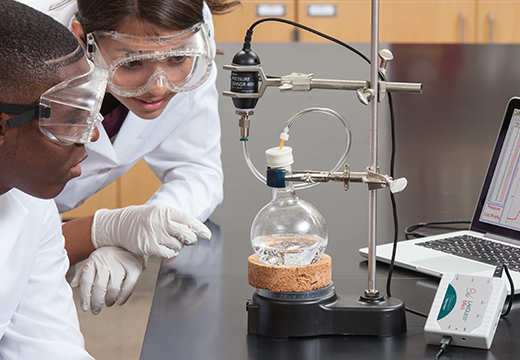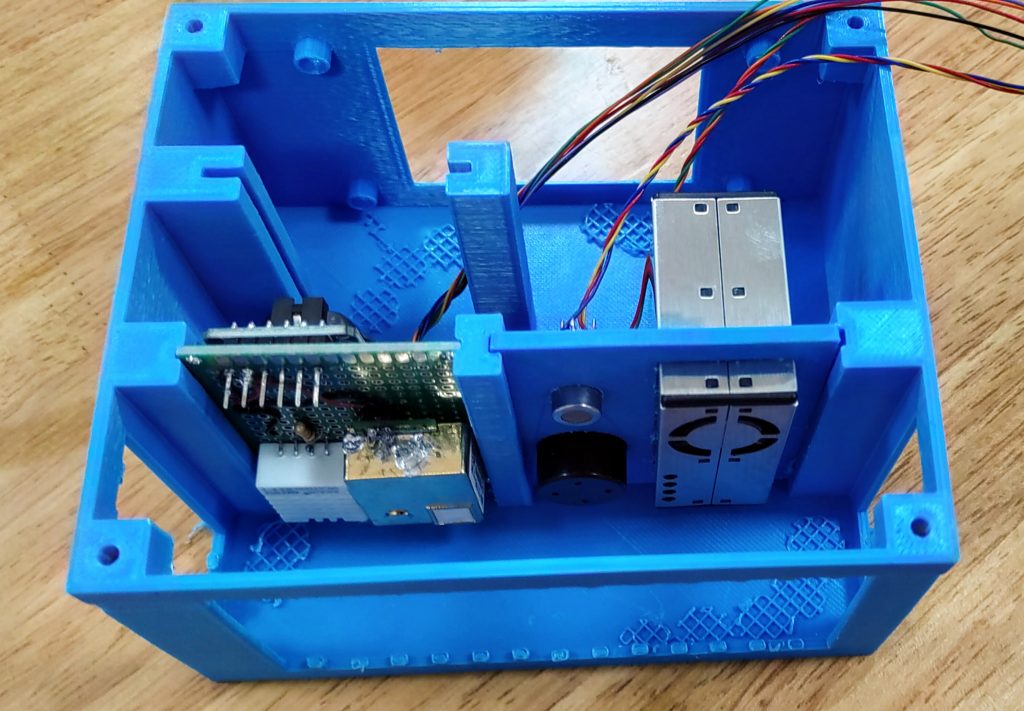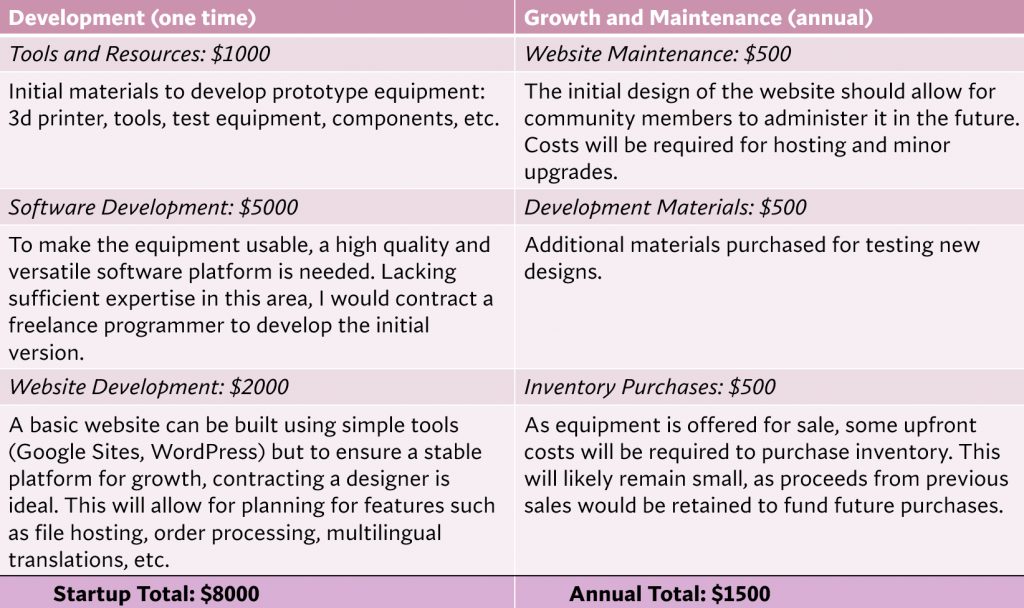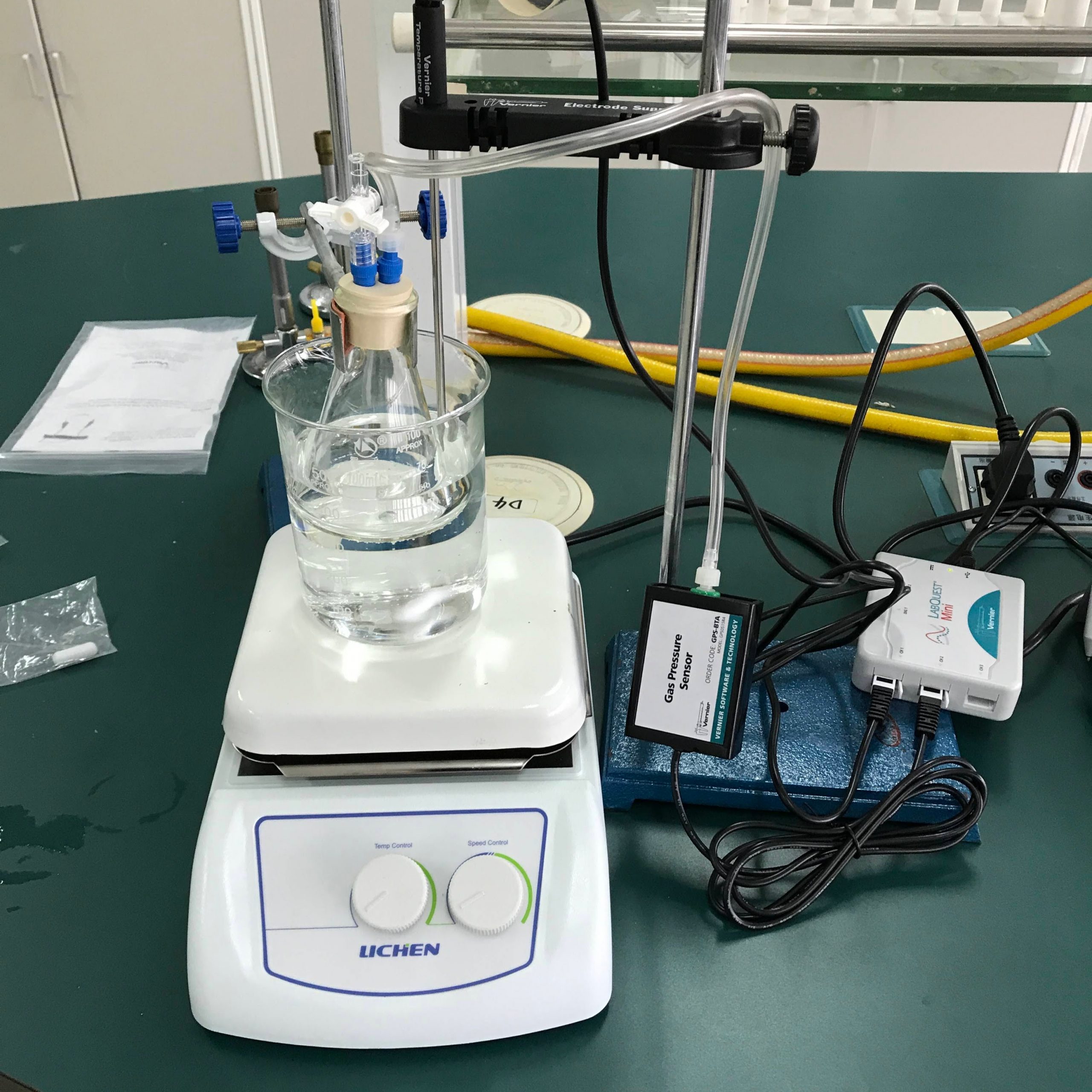As a science teacher, one of the changes since my time as a student that most impresses me is the improvement in lab equipment. Computer connected measuring tools allow students to investigate phenomena at a much deeper and subtler level than before, and the data produced connects to mathematics, computer skills and analysis techniques in ways that more traditional methods ever could. The effect is students who can expand not only knowledge but skills in a much more holistic way.
The problem with much of this equipment is cost. Purpose designed suites of tools can represent significant costs for a school, putting it out of reach of many: schools in impoverished areas worldwide will perpetuate gaps in scientific and mathematical progress due to lack of funding. To help address this,


I am hoping to begin a venture to develop open-source lab equipment of a comparable level, giving schools various options and price points to obtain their equipment. I believe that this would not only be an equalizing tactic, but can offer enrichment opportunities to students at any school, regardless of geography or funding status.
The open-source mentality means that all designs and software source code are made available for free. This allows people to source parts from different sources efficiently (i.e. buying in local markets as opposed to importing), substituting, and modifying the designs. This model is already used in contexts such as 3d printers, with commercial products being made on a publicly available design.
Project Organization
This is a small scale, non-profit organization. The two aims are to provide access to high quality lab equipment for schools and students otherwise unable to, and to offer rewarding activities in the pursuit of this first goal, irrespective of demographic.
Much of the work to develop and expand the suite of lab equipment is intended to be done by teachers and students. Instead of outside companies selling to schools, the development process becomes integrated into the worldwide school infrastructure.
Beyond making affordable equipment, the process offers valuable opportunities to those involved. As many schools, curricula or jurisdictions actively encourage or even require students to engage in development and community service, this project offers such chances: designing equipment, learning electronic assembly skills, creating curriculum support or instructional videos, fund raising to donate equipment to less well-off schools.

Design Tenants
To be effective, this project entails a balance of open ended customization, balanced on a framework of versatile, inexpensive and easily obtained elements to build upon. The goal is to have a minimum effective standard, creating a basic template for future expansion. Several large scale ideas can be identified now, others will need to be finalized as part of the initial design process.


Arduino Nano boards like this provide a high degree of capability to interface with a computer and various sensors. Available for less than $20 each, they can be customized to provide control equipment and send data to a computer using a standard USB cable. Image from https://store-usa.arduino.cc/

A test project I built. This design incorporates an Arduino Nano board, custom 3d printed case and off the shelf components. This design approach could be adapted to lab equipment very easily.
Project Organization
This is a small scale, non-profit organization. The two aims are to provide access to high quality lab equipment for schools and students otherwise unable to, and to offer rewarding activities in the pursuit of this first goal, irrespective of demographic.
Much of the work to develop and expand the suite of lab equipment is intended to be done by teachers and students. Instead of outside companies selling to schools, the development process becomes integrated into the worldwide school infrastructure.
Beyond making affordable equipment, the process offers valuable opportunities to those involved. As many schools, curricula or jurisdictions actively encourage or even require students to engage in development and community service, this project offers such chances: designing equipment, learning electronic assembly skills, creating curriculum support or instructional videos, fund raising to donate equipment to less well-off schools.

In the short to medium term, this project is not expected to require dedicated, paid staff. Work will be done via community volunteering, with specialists contracted to perform tasks that the volunteer pool is unable to do, either due to lack of expertise or available time.
Initially, I intend to develop the systems and pilot them in my own classroom teaching. Not only will this provide technical and practical trials, but it will also allow me to produce samples of instruction support, and case studies of the application of the equipment. Interested students can also become involved in the development of new equipment, for example by a school engineering club.
With some initial prototypes developed, community engagement can begin, by leveraging related networks, such as International Baccalaureate schools and teachers, regional groups of international schools, etc. As interest develops, we can then begin compiling some materials to offer kits or complete equipment for sale to similar schools. From my teaching background, this will likely be in private international schools, which feature relatively high levels of student engagement and financial support.
The next level involves expanding to offer the equipment and resources to a wider range of schools. As community engagement is a goal of many schools, this becomes an ideal chance for student involvement in reaching out to rural schools, translating resources, hosting fundraising or awareness campaigns, etc.
The final step involves making this a self-sustaining process. New equipment can be designed and existing ones improved. Community members can discuss usage strategies, post modified designs, curriculum support materials, etc.
Financial Aspect
With a focus on volunteer opportunities and a non-profit mentality, initial and ongoing costs are modest. Funding can come from a number of sources, reducing the amount of commitment asked for from any one donor.
- Direct donations – money, time, equipment/supplies, labor
- Crowdfunding – Kickstarter, Patreon
- Schools – funding for extracurricular activities, community service projects, teacher professional development allowances
- Educational Organizations – grants from government, NGO and other groups supporting education

Part of the proposal is to offer components, kits and complete equipment for sale. These will be priced slightly above cost, to both maintain the mission of equitable access to equipment, and to provide a small amount of funding. For schools in a high need situation, prices can be at or below cost, using the earnings from general sales to subsidize these cases.
Conclusion
In education, the desire to embrace modern technology is met with the harsh practicality of limited budgets. This limitation is going to be harder to navigate on schools with less funding to begin with, perpetuating gaps between students, families and regions. I believe that part of the solution can be to become more self-sufficient, relying more on internal actions than outside sponsors.
As educators, we want students to engage in real-world learning, we want them to become involved in supporting others and having meaningful impact while they are students. By creating an open network to help schools create their own lab equipment, we can take a prosaic issue of budgeting, and create powerful and real learning, engagement and involvement in solving the problem.

About Me
After obtaining a degree in engineering physics, I became interested in education, and have worked as an English language teacher, instructor of adults, and high school math and science teacher. Along the way, I obtained and MBA and an education degree. I’m now working on my master’s in educational technology to help integrate these various influences.
Having taught for years in international schools in Asia, my experiences as a teacher and traveler have made me increasingly concerned with the disparity that educational funding can have. This project is an attempt to offer a solution.
~ Devon Bobowski B.Eng, B.Ed, MBA

Hi Devon,
There are several components to your vision here that I found very inspiring. First, that you plan to utilize your classroom as the launch point and thereby researching the effectiveness as you go, and even involving students. Secondly, as an outsider (speaking from a non-physics background here), it would seem to me that there is an educational process in building the lab equipment itself. The expensive factory made items are nicely packaged up into ready to use tools, however having to put together at least some of the components may help students demystify the technology in and of itself. Lastly, I love that you are envisioning the power of technology to break down some financial barriers to entry, thereby leveling the educational playing field.
Well done! I wish you the best of luck. Your project seems very low (financial) cost and so might actually be able to be launched with minimal investment!
-Rich
FEEDBACK:
One can’t help but trust you in this elevator pitch. It conveys a sense of people banding together, experts with other experts, and crucially, experts with novices (students) for a shared, noble goal. This pitch has a revolutionary feel because it uses an Open Source framework. So many of our ventures (including my own) pay homage to the traditional, profit-driven business model. My favourite part of this venture is in the use of Open Source as pedagogy: in making the equipment accessible and in the collaborative aspect, students are learning that this is the way to approach technology and learning.
Hello Devon,
I think this idea has great merrit and I actually think you are limiting this project by not thinking bigger.
This tool could be used world-wide and in dozens of different scenarios. I so think that the cost to create and maintain this tool is a bit low when you look at the cost of salaries for developers, marketers, and more.
However, as an investor I would choose your tool to invest in. The applications for something like this are so far reaching and could be implemented in all corners of the globe. What you said for those who have and those who have not, was a great personalized touch as well. I will say that your information could have been presented in a little bit more of an engaging way but you had impressive content that overshadowed it.
Well done and I think you should pursue this venture!
Hi Devon! Great idea for a proposal. I definitely think that it is something that will make advanced technologies more accessible in the future. I know that I would have loved something like this growing up. My only concern was your elevator pitch. I enjoyed how you included your own experience in the pitch but I also had to watch it twice in order to get what you were selling. I appreciated how you made a main focus of this as trying to reduce costs (3D printing and other technologies sometimes has a very large price tag). great idea. Sam
Hello Devon,
I appreciate you sharing an elevator pitch with you being the one narrating it. I believe this gives a personal touch and helps capture a potential investor’s attention. I like that you clearly pointed out the problem and the benefits of your idea. I didn’t quite catch what the idea was in your elevator pitch – I would suggest making this clearer. You offer valuable information throughout your venture pitch. To strengthen your work, I suggest enhancing the appeal of your venture pitch. I wouldn’t necessarily eliminate the content you provided because this information helps make your idea credible. However, you may want to consider offering less information upfront and using features like interactive buttons, links, and/or collapsible sections that the viewer can click on for more detail if desired. Key points that capture attention will surely make potential investors hunger for more information. Make them curious by not giving all the information upfront. Overall, looks like a lot of effort went into your work. Thank you for sharing.
Emma
REVIEW:
Your venture idea is fantastic. The opportunity and market gap is clear – your venture addresses a real need in education by making high-quality lab equipment more accessible, especially to schools with limited budgets aka public schools! The open-source approach not only reduces costs but also has a neat secondary element of promoting collaboration and skill development among teachers and students. As a leader of this venture, your background in engineering physics, education, and international teaching experiences gives you a unique perspective and demonstrates expertise. Finally, being able to actually see what it might look like is a great addition to the pitch.
I am not concerned with the “flashiness” of your pitch, but wondering about what the actual ask is from you. Your financial section highlights that money will come from direct donations, crowdfunding platforms like Kickstarter or Patreon, schools and grants from educational organizations, governments, NGOs, and other supporting groups. When working as a non-profit, there might be a need to distinguish a donation from an investment. Today, as an EVA, I want to invest but I don’t know what I might expect as a return, so I feel like my investment might actually just be a donation. I have no problem with this, but I think providing clarity here would be my next suggested step in refining your venture pitch.
Can’t wait to see this idea come to life!
FEEDBACK
Hi Devon,
First of all, I think that open source lab equipment is a fantastic idea. There are so many schools that just don’t have the resources to access such equipment. Learning needs to be accessible for all, and I think you’re on the right track for finding that for your students. If I may ask, where would the equipment be coming from? How would you moderate its quality? As a music teacher myself, that’s something I’m constantly thinking of in terms of instruments. Would the teachers have to pay a premium for using this equipment? Overall, I think that this is a wonderful stepping off point to an excellent enterprise. In fact, speaking from the viewpoint of a music teacher, would this open source equipment include music equipment as well, or would it be just science? I’m just wondering, and I do respect science for sure. Overall, great idea and great presentation. I myself found it difficult to come up with an important learning enterprise. I think you’ve seriously got a great idea here.
Thank you for sharing,
Adam Turpin
REVIEW:
The concept of Open Source Lab Equipment is revolutionary, and I am enthusiastic about it as an investment opportunity. The International Baccalaureate (IB) program places a strong emphasis on global engagement and community service. However, such service and engagement can come across as an afterthought or inauthentic. This venture integrates community service into the educational process. In developing their skills, students are also contributing to the principle of equity in education.
Even when the will is there, it can be challenging for privileged students to make a concrete connection with communities that are less privileged or under-resourced compared to their own. Open Source Lab Equipment would allow such students to make a meaningful impact.
Of course, the success of this venture depends on the dedication and talent of individuals like yourself. I appreciate how this venture encourages a paradigm shift: it disrupts the mindset that dependence on costly commercial products is necessary and instead promotes a can-do attitude and a spirit of self-sufficiency. It empowers students with the realization that they can produce the necessary educational tools themselves, enabling them to become not only capable scientists but also positive contributors to the global community.
Well done, Devon!
Hi Devon,
I enjoyed the personalized elevator pitch – right from the start your personal engagement and experience is a selling feature. You foster trust and draw attention to the need.
I think this is a fantastic idea, and I hope that you do it. As a small-scale not-for-profit operation, I think that your sourcing of funding would go well in seeking out individuals who are happy to donate and improve educational access for our students. Collaboration often seems to be just about ideas, but this collaborative opportunity is incredibly hands-on and trackable.
Pitch this for real – I think it’ll work.
Hi Devon,
I like the idea here. My only question is that will there be someone on site to assist the acquisition and set up? I would feel a bit overwhelmed especially as I’ve heard of Arduino products but have no knowledge to use it. I understand that there would be professional development but I wonder, would you provide someone on site for the initial part? I like the open source concept but if one is not trained, I feel a little more support would help. Other than that, I like the idea. Thank you for putting together!
Jeremiah
REVIEW:
Hi Devon,
Your venture has a truly inspiring mission! It cleverly addresses the real-world problem of limited access to lab equipment in schools, especially those with tighter budgets. The open-source model is brilliant – it tackles costs while fostering a wonderful sense of community and skill-building. Your background is perfectly suited to lead this project, combining expertise in engineering, education, and diverse teaching experiences. The visual prototype brings the concept to life, which is fantastic. I currently work at a more financially stable school and I still find myself lacking budget for high end sensors so I can certainly see your model becoming a valuable asset to educators everywhere. I also love your idea of community members coming together to share ideas and support each other. I think that would be ideal for troubleshooting and improving the products over time.
I also found your pitch to be very sincere. However, I think it could be clearer what you are asking from investors and what they should expect to receive in return. That being said, I personally would throw money at you if I had it because I think this idea will be revolutionary here in Canada, and maybe even world wide as 3D printers become more prolific.